The global custom binders market is projected to grow from USD 34.6 million in 2025 to USD 64.3 million by 2035, expanding at a CAGR of 6.4%. Custom binders form a niche within the broader office supplies market, which was worth USD 121.2 million in 2025. As a result, custom binders account for a 28.5% share of the total office supply spending globally.
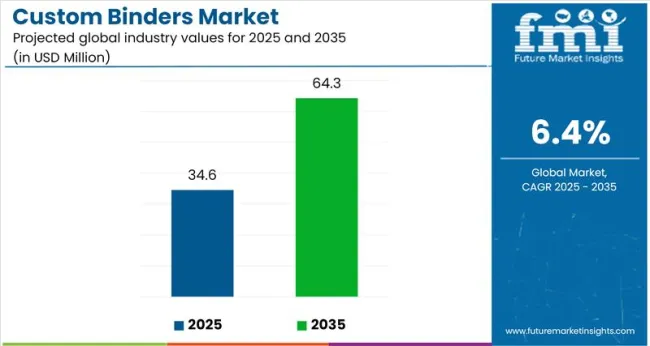
| Metric | Value |
|---|---|
| Market Size 2025 | USD 34.6 Million |
| Market Size 2035 | USD 64.3 Million |
| CAGR 2025 to 2035 | 6.4% |
Despite office digitalization, institutional and corporate branding needs continue to fuel demand for physical presentation materials, including binders. Customization for legal, educational, and corporate documentation has supported steady growth in paper-based accessories, particularly in North America and Western Europe. Use cases in client presentations, compliance submissions, and training documentation reinforce binders’ functional relevance.
However, cost-conscious buyers and rising material costs have constrained premium adoption in some regions. Vinyl and synthetic input prices have increased, while competition from digital archiving tools has limited penetration in tech-forward economies. EU environmental directives have also added compliance pressure on plastic-heavy formats, causing procurement delays or reformulation.
Material innovation and on-demand manufacturing have unlocked new revenue pockets, especially for short-run and highly customized binder orders. Paperboard-based alternatives have gained traction amid tightening single-use plastic norms, boosting their share to 54%. Players offering flexible customization at low minimum order quantities (MOQs) are best placed to scale through 2035.
Global custom binder market has been segmented by Material Type (Paper & Paperboard, Plastic); by Product Type (Hardcover Binders, Decorative Binders, Softcover Binders, Punchless Binders, Ring Binders); and by End Use (Institutional, Commercial, Household); with regional coverage spanning North America, Latin America, Western Europe, Eastern Europe, East Asia, South Asia & Pacific, Middle East & Africa.
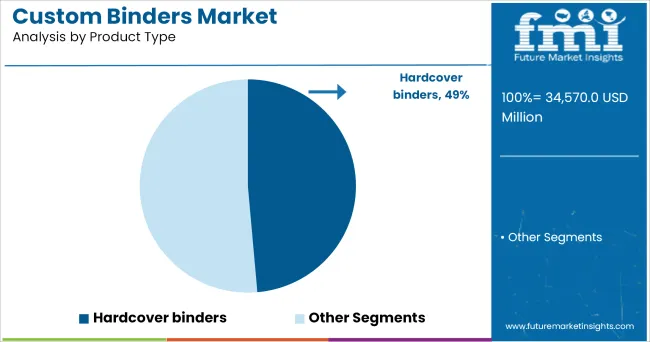
Preferred in legal, academic, and enterprise documentation, hardcover formats are favored for their structured form and longer shelf life. However, their higher cost base and heavier weight have posed a barrier in cost-sensitive and remote geographies.
Manufacturing automation, especially in casing-in and spine reinforcement processes, has helped reduce per-unit cost by 12-15% since 2020, enabling better margins.
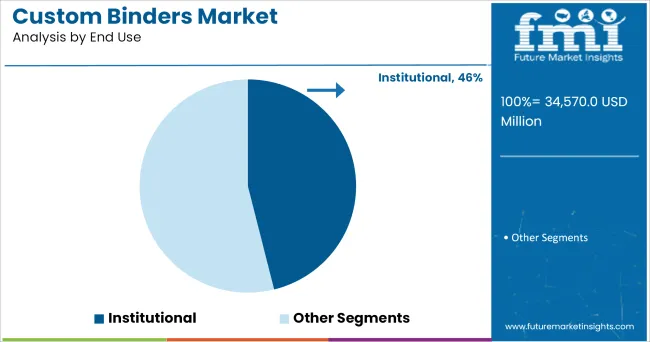
Growth is underpinned by consistent procurement from government agencies, public education boards, and healthcare systems, all of which require standardized formats for recordkeeping, compliance, and formal communication. Orders are typically structured into long-term contracts or annual tenders, with repeat volumes minimizing per-unit negotiation.
While commercial and household use of binders is growing-particularly via online retail-these segments face greater pricing volatility and demand fragmentation. Institutional buyers, by contrast, prioritize consistency and physical durability, making them less reactive to price hikes or digital substitutes.
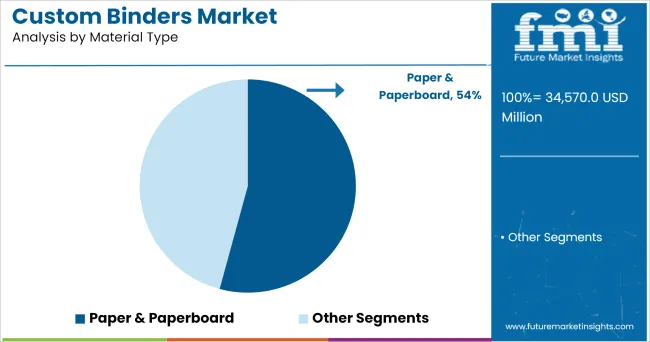
The shift is strongly influenced by regulatory interventions, especially in Europe and the USA, where plastic-based office supplies face procurement restrictions under green purchasing mandates. Paperboard formats have benefitted from recyclability advantages and their ease of branding through digital or offset printing.
Unlike plastic, which may require specialized coating or lamination, paperboard offers a ready surface for low-cost customization-particularly attractive to schools, government offices, and NGOs. This cost-performance balance is expected to make Paper & Paperboard the default substrate in institutional and mid-volume commercial orders.
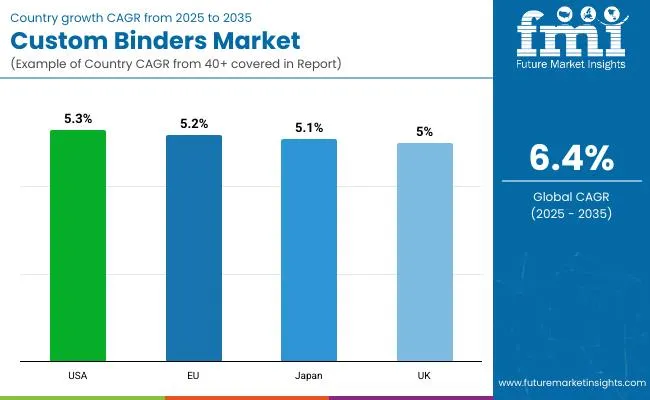
Demand for custom binders across mature economies is expected to follow a stable, upward trajectory through 2035, with institutional and regulatory momentum playing a central role. In the United States, procurement patterns are shaped by continued reliance on physical documentation in public education and legal systems, alongside small-batch customization trends in enterprise settings. Across the European Union, demand is reinforced by compliance-driven use in government and education, where single-use plastic bans are also tilting preference toward paperboard formats.
Japan’s market remains structured around meticulous documentation standards in corporates and municipal bodies, while the United Kingdom shows growing adoption among SMEs, supported by domestic print-on-demand services and a recovering retail stationery segment. Across all four, digital shift pressures exist, but consistent demand from public institutions ensures physical formats retain a durable niche.
The USA custom binders market continues to demonstrate consistent growth, primarily anchored in the education, legal, and public administration sectors. School districts, municipal authorities, and healthcare institutions generate repeat demand through annual procurement cycles, reinforcing physical binder usage despite ongoing digitization. Private sector uptake is led by mid-sized enterprises, where customized binders are still used for training materials, onboarding kits, and client-facing documentation.
E-commerce has enabled cost-effective personalization, with a growing number of domestic converters offering print-on-demand services for small batch runs. Moreover, local sourcing preferences and compliance with state-level public procurement standards have insulated the market from global supply chain volatility, supporting volume stability even during periods of economic adjustment.
Demand across the EU-27 remains shaped by regulatory compliance, public-sector procurement policies, and environmental mandates. Government institutions, universities, and NGOs continue to rely on physical binders for document organization and public records. A key growth lever has been the phase-out of non-recyclable plastic materials under circular economy policies, redirecting procurement toward paperboard and bio-based alternatives.
Countries like Germany, France, and the Netherlands have shown steady institutional consumption, while Eastern European states are catching up through infrastructure modernization programs. Vendors with EU Ecolabel certification or national green procurement compliance have secured multi-year supply contracts, particularly for ring binders and hardcover formats. Although hybrid work policies have softened demand from office-based sectors, public frameworks continue to sustain baseline volume growth.
Japan’s market is distinguished by a cultural and institutional preference for physical document archiving, which has ensured the continued relevance of custom binders in corporate and public workflows. Government departments, banks, and real estate firms maintain strict filing protocols, where binders serve as a core part of structured paper management. Schools and private academies also contribute to volume through curriculum packaging and administrative usage.
The domestic industry is characterized by high-quality, precision-oriented production, with an emphasis on compact form factors and durable finishes. Decorative and limited-edition binders have emerged as a niche in the consumer and gifting segments, particularly for students and hobbyists. While digitization efforts exist, they are selectively implemented, leaving substantial room for physical documentation tools over the forecast period.
The UK binder market reflects a hybrid model, balancing institutional continuity with evolving small-business needs. Government-funded schools, NHS trusts, and local councils continue to rely on structured binder systems for audits, training, and reporting, generating predictable annual demand. SMEs have embraced branding-led customization, using binders in proposal decks, internal training, and marketing deliverables. Since Brexit, domestic producers have benefited from reduced EU competition, leading to a modest reshoring of demand.
Print-on-demand services have expanded into regional hubs, catering to fast-turnaround needs. However, inflation-linked cost pressures and an ongoing digital transition in corporate offices present mild headwinds. Despite this, the embedded use of binders in education and professional services ensures a resilient baseline of usage across both public and private sectors.
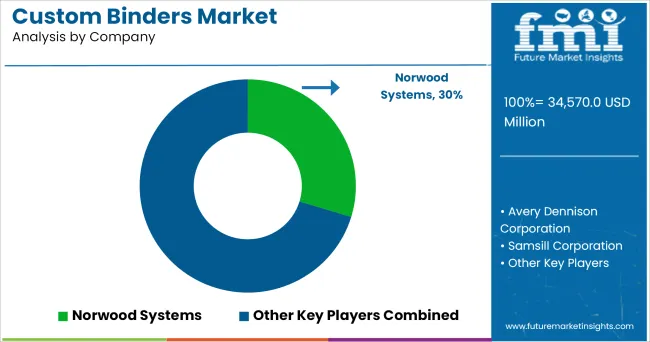
The players in the custom binders market are focusing on differentiated design capabilities, sustainable material sourcing, and short-run digital customization to retain institutional and commercial clients. Leading companies like Norwood Systems and Avery Dennison are investing in automation for large-volume procurement contracts, especially in education and government segments. High-capacity manufacturing and regulatory compliance have helped them secure multi-year supply agreements with public institutions across North America and Europe.
Tier-2 manufacturers such as Samsill Corporation and niche regional firms are targeting mid-market clients and SMEs by offering flexible minimum order quantities (MOQs), variable binder styles, and on-demand printing. These players operate leaner production models and frequently integrate with e-commerce platforms to capture direct-to-consumer and small business sales. Customization, speed, and pricing remain their core value propositions.
Startups and local converters have entered the space through Etsy-like channels and localized Shopify storefronts, offering highly personalized, aesthetic-driven binders for retail and household use. While their scale is limited, these players are reshaping the decorative and gifting segment, pushing legacy players to adapt SKU strategies.
By 2035, the winners will likely be those combining compliance-ready formats with modular customization-able to scale institutional volumes while addressing aesthetic and niche-use personalization. Late movers reliant on standard mass production will face margin compression and shrinking public contracts.
| Attribute | Details |
|---|---|
| Market Size (2025) | USD 34.6 million |
| Market Size (2035) | USD 64.3 million |
| CAGR (2025 to 2035) | 6.4% |
| Base Year | 2024 |
| Historical Period | 2020 to 2024 |
| Forecast Period | 2025 to 2035 |
| Unit | USD Million |
| Segments Covered | By Product Type, Material Type, End Use |
| Product Types | Hardcover Binders, Decorative Binders, Softcover Binders, Punchless Binders, Ring Binders |
| Material Types | Paper & Paperboard, Plastic |
| End Use | Institutional, Commercial, Household |
| Key Regions | North America, Latin America, Western Europe, Eastern Europe, East Asia, South Asia & Pacific, Middle East & Africa |
| Key Countries Covered | United States, United Kingdom, Germany, France, Japan and 40+ countries |
| Key Companies | Norwood Systems, Avery Dennison Corporation, Samsill Corporation, Other Market Participants |
The global custom binders market is estimated to be valued at USD 34.6 million in 2025.
The market is projected to grow at a CAGR of 6.4% during the forecast period.
Hardcover binders dominate with a 49% share in 2025 due to institutional preference.
Norwood Systems leads, followed by Avery Dennison Corporation, Samsill Corporation, and other regional players.
Paper & Paperboard holds the largest material share at 54%, supported by regulatory trends favoring recyclability.






Full Research Suite comprises of:
Market outlook & trends analysis
Interviews & case studies
Strategic recommendations
Vendor profiles & capabilities analysis
5-year forecasts
8 regions and 60+ country-level data splits
Market segment data splits
12 months of continuous data updates
DELIVERED AS:
PDF EXCEL ONLINE
Custom Packaging Box Market Size and Share Forecast Outlook 2025 to 2035
Custom Face Care Market Forecast Outlook 2025 to 2035
Customized Skincare Market Size and Share Forecast Outlook 2025 to 2035
Custom Peptide Synthesis Services Market Size and Share Forecast Outlook 2025 to 2035
Customer Service Software Market Size and Share Forecast Outlook 2025 to 2035
Custom Vacation Planning Market Size and Share Forecast Outlook 2025 to 2035
Customer Revenue Optimization (CRO) Software Market Size and Share Forecast Outlook 2025 to 2035
Customer Communications Management Market Size and Share Forecast Outlook 2025 to 2035
Customer Experience Management (CEM) In Telecommunication Market Size and Share Forecast Outlook 2025 to 2035
Custom Dry Ingredients Blends Market Analysis - Size, Share and Forecast Outlook 2025 to 2035
Customer Engagement Hub (CEH) Market Size and Share Forecast Outlook 2025 to 2035
Custom Probiotics Market Size and Share Forecast Outlook 2025 to 2035
Customer Journey Analytics Software Market Size and Share Forecast Outlook 2025 to 2035
Customer-To-Customer (C2C) Community Marketing Software Market Size and Share Forecast Outlook 2025 to 2035
Customer Journey Mapping Software Market Size and Share Forecast Outlook 2025 to 2035
Customized Premix Market Analysis - Size, Share, & Forecast Outlook 2025 to 2035
Custom Printed Tape Market Size and Share Forecast Outlook 2025 to 2035
Customisation and Personalisation in Travel Market Size and Share Forecast Outlook 2025 to 2035
Customer-Facing Technology Market Size and Share Forecast Outlook 2025 to 2035
Custom Display Packaging Market Analysis - Size, Share, and Forecast Outlook 2025 to 2035

Thank you!
You will receive an email from our Business Development Manager. Please be sure to check your SPAM/JUNK folder too.
Chat With
MaRIA